Mixed Flow Fan: Hybrid Design for High Performance
Mixed flow fan is a specialized fan type that combine features of both axial and centrifugal fan. In a mixed flow design, air enters axially (parallel to the shaft) and is then deflected outward radially by angled blades. This “diagonal” flow path lets mixed flow fan achieve higher static pressures than a simple axial fan while maintaining large volume flow. The impeller of a mixed flow fan typically has blades set on a conical or cylindrical hub, blending axial and radial geometry. This hybrid geometry boosts pressure (like a centrifugal fan) without sacrificing the high flow rate of an axial unit, making mixed flow fan efficient and versatile.
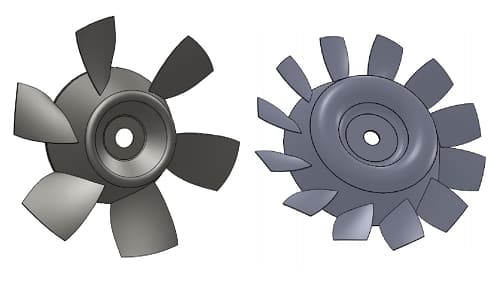
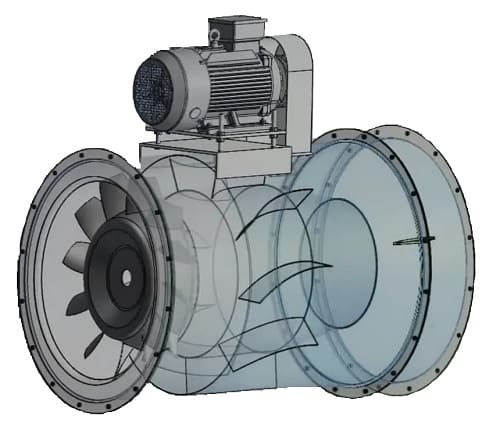
Impeller Types of Mixed Flow Fan Mixed Flow Fan (Belt Drive)
Engineering Design and Aerodynamic Principles
Mixed flow fan impellers have blades arranged at a diagonal angle (often around 45°) relative to the shaft. As incoming air streams straight into the fan, these blades impart a combination of axial lift and radial spin. The result is a swirl that compresses the flow outward while still pushing it forward. The air ultimately exits at a direction between straight out and perpendicular, leveraging both centrifugal pressure and axial velocity. This design effectively “bridges” the performance gap between axial and radial fan. Key design characteristics include:
-
Impeller geometry: Blades on a conical or tapered hub, angled to generate pressure (typically 30~60° tilt). The hybrid shape combines smooth axial flow with radial acceleration.
-
Flow path: Inlet flow is axial; blades turn the flow outward. This diagonal deflection (about 45°) maintains high flow rate and significantly boosts static pressure.
-
Speed and torque: Mixed flow fan often runs at moderate RPMs. The design can achieve the needed pressure without extremely high speeds, which reduces stress on the motor.
-
Aerodynamics: The angled blades reduce turbulence compared to pure axial designs, smoothing the airflow and improving efficiency. The combination of forces on the air minimizes recirculation and losses.
Performance Benefits vs. Axial and Centrifugal Fan
Mixed flow fan delivers a blend of the best traits of axial and centrifugal types, yielding several performance advantages:
-
Higher Static Pressure: Mixed flow fan develops significantly higher pressure rise than purely axial fan. This makes them suitable for systems with moderate resistance (long duct runs, filters, or heatsinks). In practice, a mixed flow unit can reach the mid-to-high hundreds or thousands of Pascals, similar to many centrifugal fans, but in a more compact package.
-
High Efficiency: The intermediate design often achieves peak efficiencies near those of comparable centrifugal fans. In many cases, a mixed flow fan will be slightly more efficient than an axial fan of similar power, especially at moderate pressure rises. The smooth, diagonal flow path reduces losses, so mixed flow fan can consume less power for the same airflow compared to less optimized axial designs.
-
Lower Noise: By reducing turbulent eddies through its angled-blade geometry, a mixed flow fan generally operates more quietly than a high-speed axial fan or equivalent centrifugal unit. The airflow is steadier and the motor loads at lower RPM, which cuts both aerodynamic and mechanical noise. This quiet performance is why mixed flow fan is often specified where noise control is important.
-
Compact Footprint: Mixed flow fan packs high performance into a relatively small housing. They typically require less casing volume and have a simpler duct connection than a comparable centrifugal unit. For a given airflow and pressure, a mixed flow fan’s size is closer to that of an axial fan, making it easier to fit into tight spaces. This compactness also means lower weight and smaller foundation or mounting needs in buildings or on rooftops.
-
Wide Operating Range: Mixed flow fans maintain stable operation across a broad flow-pressure range. They handle surges and partial load conditions better than axial fans, and unlike some radial fans, they don’t stall or lose efficiency abruptly if airflow changes. This robustness can simplify ventilation system design and reduce the need for variable-speed drives in some cases.
In summary, mixed flow fan often strikes a practical balance: it produces more pressure than axial fan but at a size similar to an axial fan. They offer efficiencies and quietness approaching centrifugal models without the full bulk of a radial fan. As a result, mixed flow fan is a preferred commercial fan or industrial fan choice when moderate-to-high airflow and pressure are required in one unit.
Applications in Various Sectors
Mixed flow fan is used across many industries. Its versatility makes it ideal for ventilation, air handling, and exhaust tasks where space or noise is constrained but performance is critical. Key applications include:
Commercial Buildings
In commercial complexes like shopping malls, office towers, and high-rise developments, mixed flow fan often serves as supply or exhaust fan. It can handle the building load more effectively than simple propeller fan. Because mixed flow fan is relatively compact and quiet, it fits well in commercial fan units that demand low noise. It is commonly integrated with fire smoke damper systems for stairwell pressurization: during a fire, a mixed flow fan can quickly supply or exhaust air through smoke dampers to control smoke spread, meeting safety codes while maintaining airflow. The fans are often rated for continuous duty and may include VFD (variable frequency drive) controls to modulate flow and save energy.
Industrial Facilities
Mixed flow fan is common in factories, plants, and process industries. It excels at tasks like dust collection, drying, cooling, and general ventilation. For example, a mixed flow fan can ventilate a machine hall or warehouse more effectively than an axial fan, without requiring the oversized footprints of a centrifugal fan. Many industrial fan installations mount mixed-flow units with belt drives and large motors for flexibility and ruggedness. The fans are often built to resist chemical or abrasive materials, and stainless steel or coated wheels are used if needed.
Rooftop Installations
In many buildings, a roof fan (either intake or exhaust) is needed to ventilate equipment rooms, kitchens, or general spaces. Mixed flow roof fan is popular because it can sit on standard roof curbs and push air vertically through the roof. The slim design means the roof fan unit is not much taller or heavier than an axial roof fan, yet it can overcome ductwork or grill resistance more easily. This is especially useful for rooftop makeup air units or smoke exhaust vents. Mixed flow roof fan is also sometimes used for cooling towers or condensers: by combining airflow and pressure, it can draw air through the heat exchanger cores more uniformly. Proper weatherization (rain hoods, guards) is applied, and the fan’s compact motor bracket fits many roof applications.
Nuclear Power Facilities
Nuclear plants have extremely stringent ventilation requirements. Mixed flow fan in nuclear settings is typically used in safety-related ventilation loops, such as emergency exhaust for containment or fresh air supply to safety rooms. Because nuclear buildings are often confined and heavily filtered, a mixed flow fan’s ability to generate significant pressure in a small package is valuable. Manufacturers must follow nuclear design standards and use materials that withstand high temperatures and radiation. If used in radioactive zones, these fans may have special coatings and monitoring to ensure decades of reliable duty. The nuclear grade fan designation often implies a higher inspection/certification level, which mixed flow designs can meet while delivering the needed flow and pressure.
Fire Safety and Smoke Control
In fire and life-safety systems, mixed flow fan is frequently tied into smoke control schemes. For example, a mixed flow smoke exhaust fan may be connected to a shaft with a motorized fire smoke damper. Under normal conditions the fan ventilates corridors or maintains pressurization. When a fire is detected, the damper opens and the mixed flow fan ramps up to remove smoke or provide clean air. Because mixed flow fan can deliver both high flow and high pressure, it can overcome the sudden back pressure of fire-rated dampers and duct resistances.
Conclusion
Mixed flow fan offers a compelling combination of air moving performance, efficiency, and compact size. By channeling air through both axial and radial components, it fills a unique niche between propeller-type and conventional centrifugal fans. This makes it especially suitable for applications like commercial HVAC, industrial exhaust, rooftop ventilation, and even stringent nuclear facilities. In each case, the hybrid design yields higher pressures than simple axial fan and lower noise than most radial fan. Its versatility ensures that engineers and contractors can rely on mixed flow fan as a commercial fan, industrial fan, roof fan, or nuclear grade fan solution, and additionally, integration with fire smoke damper systems for emergency smoke control.
In summary, mixed flow fan delivers efficient, quiet, and high-pressure ventilation in a form-factor that fits many commercial, industrial, and infrastructure projects. Its carefully engineered impeller and housing make it a robust choice for any environment where reliability and performance are paramount.
Note: The data is for reference only, please consult relevant companies for details. And the content of the article cannot avoid omissions and errors. Welcome to propose corrections.
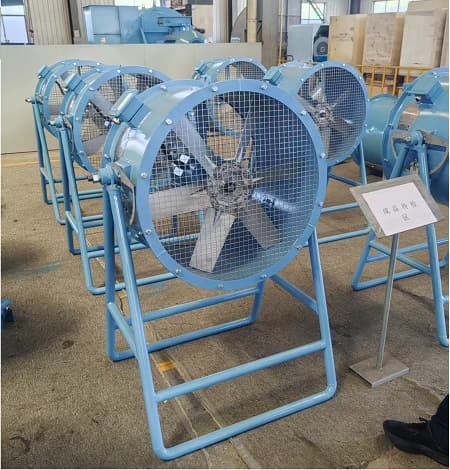 Mancooler (Workstation) Fans — Why Your Factory Needs the Right One
Mancooler (Workstation) Fans — Why Your Factory Needs the Right One
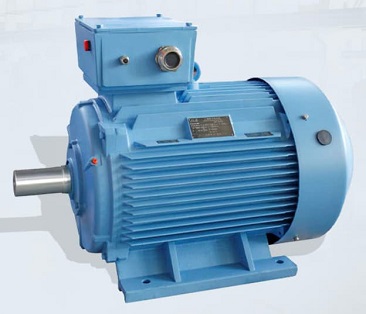 Motor Classifications in Industrial Fans
Motor Classifications in Industrial Fans
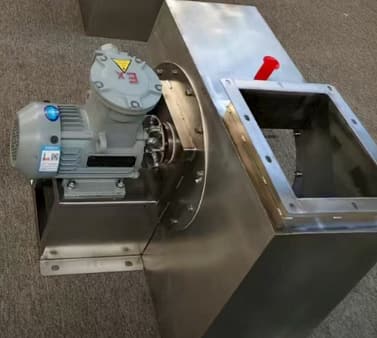 Materials for Explosion-Proof Fan
Materials for Explosion-Proof Fan
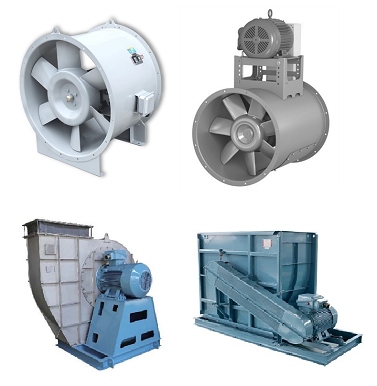 Direct Drive vs. Belt Drive in Axial Fan and Centrifugal Fan
Direct Drive vs. Belt Drive in Axial Fan and Centrifugal Fan

